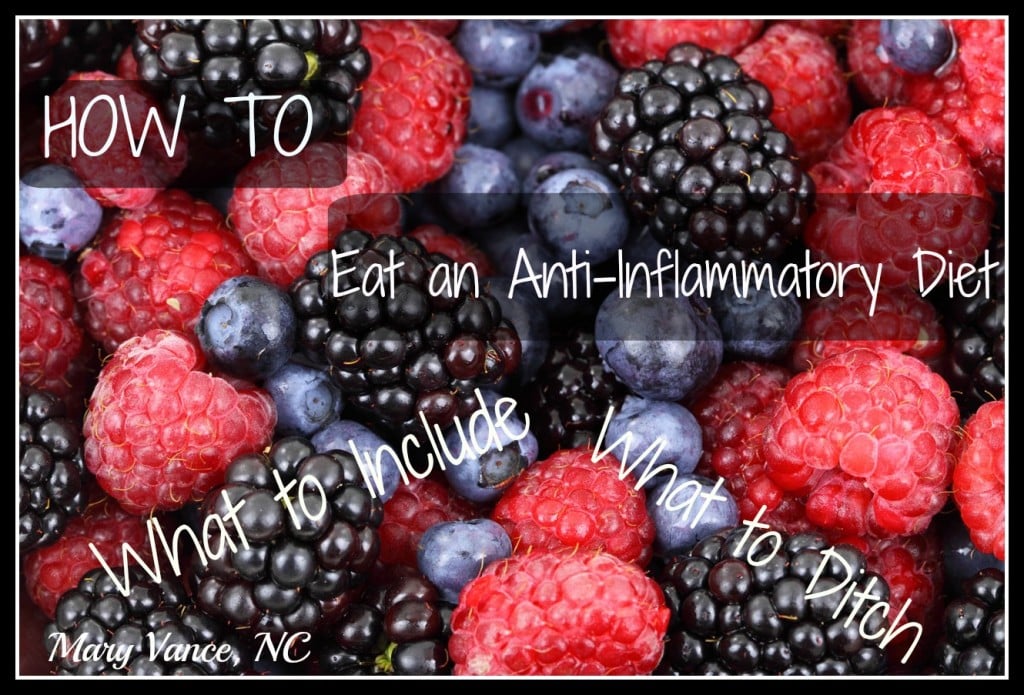Inflammation is arguably the root cause of every chronic condition and disease. It’s your body’s response to stress, whether it be stress via injury, diet, lack of sleep, too much work, toxic emotions, stored trauma, or internal or external toxins. You can fight inflammation with your fork! The anti-inflammatory diet is an eating plan that’s low in foods that trigger inflammation in most people. Following an anti-inflammatory diet can reduce your risk of chronic inflammation, which contributes to cardiorespiratory diseases, cognitive diseases, and even cancer. It also boosts longevity and slows the aging process.
What is Inflammation?
Think about what happens when you cut or burn your finger: It swells and turns red and warm as your body sends white blood cells to the injury site to prevent foreign invaders from causing infection. The swelling caused by this reaction is inflammation, and it is good, in this instance. Or if you sprain your ankle, the resulting inflammation is all part of the healing process. This is acute inflammation. Chronic inflammation is another story.
Chronic, low grade inflammation is a constant assault on your body. Much of this inflammation originates in the gut, believe it or not, due to unfavorable bacteria overgrowth and foods that trigger initial inflammation. Many of these foods are obvious, like fast food, sugar, processed foods, damaged fats (think hydrogenated), refined white flour, dairy. But the confusing part is many foods considered “healthy,” like eggs, wheat, or tomatoes, can cause inflammation in certain people.
Inflammation & The Gut
Your gut benefits greatly from an anti-inflammatory diet because a healthy gut that’s not inflamed is better able to provide housing to your beneficial bacteria.
Your gut is home to trillions of bacteria: They outnumber your cells 2 to 1 (roughly). We are now beginning to consider this gut microbiome ecosystem in your digestive tract an organ, much like your heart or liver, and it keeps us healthy, determining our weight set point and modulating inflammation and immune health. Your friendly gut bacteria digest your food for you and keep your immune system running strong.
Our diet, stress levels, exposure to toxins (pollutants, skincare products, alcohol, medications), and use of antibiotics and other meds can alter our microbiome, causing the bad bacteria to outnumber the good bacteria. This triggers the proliferation of inflammatory cytokines that travel throughout the body causing oxidative stress and free radical damage, setting the stage for inflammatory diseases such as IBS, cardiovascular disease, arthritis, autoimmune disease, diabetes, dementia, depression, Alzheimer’s, cancer, chronic skin conditions, premature aging.
You should have about 85% beneficial bacteria and 15% bad bacteria in your colon (large intestine), which are normal in every microbiome and keep us healthy by challenging your good bacteria to keep on their toes. But when the bad guys take over the good guys, problems arise. You may notice bloating, constipation, diarrhea, heartburn, fatigue, weight gain, and even joint pain. Inflammation is another result of having too much bad bacteria in the gut. Fortunately you can squash the bad guys and build up the good guys with help from your anti-inflammatory diet and some lifestyle adjustments.
How do you know if you have inflammation?
Inflammation has been called “the silent killer,” but here are a few signs:
- You have a condition ending in –itis. Any “–itis” is an inflammatory condition.
- Ongoing, irritating joint or muscle pain
- Allergies or asthma
- High blood pressure
- High blood sugar
- High LDL cholesterol levels (over 140)
- Ulcers
- Irritable Bowel Syndrome, other digestive issues such as colitis, Crohn’s
- Fatigue
- Chronic skin problems or irritations/rashes such as eczema or psoriasis
- Chronic acne
- Chronic pain
- Autoimmune condition
- Elevated CRP on lab work (over 3.0, though ideally it should be <1.0)
(for more detail on inflammation and certain blood tests you can request, click here).
Our Standard American Diet (SAD) has gotten us into trouble. The base of our food supply is refined carbs and pasteurized dairy with a hefty dose of sugar and conventionally raised animal products. Add to that the assault of our sedentary desk jobs, lack of sunlight (resulting in poor vitamin D levels), and disrupted sleep, and that is a recipe for inflammation. This lifestyle, coupled with a SAD diet high in sugar and toxic additives “generally regarded as safe” by the FDA, contributes to increased body fat and cortisol levels from chronic stress.
But you can reverse inflammation through diet and lifestyle modifications, even if you are already suffering from inflammatory conditions. Or, use theses guidelines to prevent inflammation.
How to Eat an Anti-Inflammatory Diet
There are two general principles of an anti-inflammatory diet: Eat whole foods that are rich in healthy fats and phytonutrients and maintain a stable glycemic response (avoid blood sugar spikes and crashes).
You’ll often hear that a Mediterranean type diet is the most recommended anti-inflammatory diet. It is mostly plant foods, seafood, olive oil, legumes, and nuts and seeds, with minimal red meat and dairy. Generally these guidelines are beneficial, but not everyone tolerates a higher carb diet. Keep in mind you’ll need to make adjustments depending on what works well for your body. You’ll know you’re on the right track when you have stable energy during the day, you sleep well, nagging pain disappears, and you’re pooping regularly. Additionally, your lab work should show a reduction in CRP and even lipids like triglycerides and cholesterol.
STEP ONE: Ditch the Junk
Remove inflammatory foods from your kitchen. Start with white & wheat flour products: breads, flour tortillas, pasta, crackers, baked goods, bagels, cereal, anything that contains wheat in any form. These foods contain gluten, which causes inflammation in the intestinal tract, and are usually refined, stripped of their fibers and nutrients. Studies show that gluten consumption activates zonulin, which leads to increased intestinal permeability (leaky gut). Leaky gut contributes not only to inflammation but also food allergies. Get rid of white sugar and boxed, processed foods containing any refined sugars or corn syrup.
Ditch the dairy, too. Dairy contains an abundance of a hormone called IGF-1, which is really good for baby cows, its intended recipient. But IGF-1 is a growth hormone that causes inflammation in humans. We are the only mammal that continues to consume milk into adulthood. Think about that. It’s intended as to provide growth and nourishment from mother to young. Also, many people have sensitivities to casein, the protein portion in dairy, and most adults lack the lactase enzyme needed to effectively digest it. Most dairy we consume contains antibiotics and toxins, and the pasteurization and homogenization processes damage the protein. Dairy increases insulin levels and contributes to acne. Raw milk may be ok occasionally for those who aren’t sensitive to casein. Click here to read more.
Remove all vegetable oils: canola, corn, soy, grapeseed, anything in a plastic jug that says “vegetable oil.” Get rid of hydrogenated or partially hydrogenated fats (Crisco is a main example).
Get rid of conventionally raised meats, especially beef, which is excessively high in omega 6 fatty acids. It’s also filled with antibiotics and toxins. And you don’t want to be supporting CAFO operations, which are cruel to animals and harmful to your health and the environment.
Of course get rid of processed, refined, and junk foods: chips, cereal (yes, it’s highly refined), candy, boxed foods like Rice a Roni, packaged ramen noodles, artificial colors, flavors, etc.
Inflammatory Foods to Avoid
- Gluten-containing foods like white bread and pasta
- Vegetable oils like canola, soybean, anything labeled ‘vegetable oil’
- Too much added sugar (you should not exceed 25 grams of added sugars per day)
- Packaged foods high in sodium
- Conventionally raised meat and dairy
- Trans fats (hydrogenated)
Read more: how to stock your holistic pantry.
NOTE: any food to which you have an allergy/intolerance/sensitivity can cause you inflammation. The most common are gluten, dairy, eggs, nuts, peanuts, and soy. Nightshades and grains (click here to read why) may cause issues for some, especially if you have autoimmune disease. You can easily determine your food allergies by doing an elimination diet or running a food allergy test panel to see which foods are causing an inflammatory response. (click here for the test I recommend)
STEP TWO: Stock with anti-inflammatory foods
Now, the fun begins! You get to stock your pantry and with anti-inflammatory foods. You’ve ditched the processed junk. Now, focusing on a plant-based diet (meaning half your plate is veggies of all kinds) is a great start; plants contain phytonutrients that have powerful anti-inflammatory properties. How much protein you need depends on a number of factors. Click here for more info on how to determine your ideal diet.
NOTE: if you have IBD or an inflammatory digestive condition, you may need to eat a lower fiber or lower FODMAP diet until your gut heals. Eating too much fiber can actually worsen IBD conditions.
My top billing goes to the leafy greens. Kale, collard greens, swiss chard, kale, dandelion greens, beet greens, salad greens, whatever dark leafy greens you like. They’re filled with minerals and antioxidants that combat free radical damage.
Second place goes to berries. Blueberries especially are excellent for brain health and are powerful anti-inflammatories. Berries are among the healthiest foods we can eat. They fight cancer and combat inflammation. Load up on blueberries, blackberries, and raspberries especially. Pomegranate is great too.
The cruciferous veggies (broccoli, cabbage, brussels sprouts, kale, cauliflower, bok choy) detox the body of excess estrogens (important for men too, since we’re exposed to so many environmental xenoestrogens) and are cancer-fighters too.
Omega 3 fatty acid-rich foods quell inflammation, reduce joint pain, and improve cognition and depression. It’s important to get omega 3s so you don’t have an excess of the omega 6 fats, which contribute to inflammation in excess. The average western diet includes up to 10 times more omega-6 fatty acids. Omega-3 rich foods include wild salmon, sardines, rainbow trout, chia seeds, walnuts, and spinach. You cannot produce omega 3s, so you must obtain them from food.
Legumes, especially lentils, provide tons of fiber (lentils come in at a whopping 18g per cup!) to feed your beneficial gut bacteria so they keep digestion and immune health running smoothly.
Fermented foods provide you with the probiotics needed for a healthy gut. And we all know healthy gut bacteria are crucial for keeping inflammation in check. Get fermented foods daily. Raw kraut or fermented veggies are the best source, followed by fermented beverages (kvass, water kefir, kombucha) and apple cider vinegar.
When choosing animal protein, always buy organic. Grass fed beef, for example, has a great omega 3 fatty acid composition (unlike its CAFO counterpart). Make wild fish and seafood your priority. If you are actively working to reduce inflammation, cut down on your red meat consumption (once a week max, if that). Choose from cage free eggs (from a local farmer if you can get ’em); grass fed beef, lamb, and bison; organic chicken and poultry; and liver. Animal protein turns on inflammation in the body if it’s conventionally raised and full of toxins, antibiotics, and unhealthy fats. We know that the populations that live the longest don’t eat much meat and hardly any red meat. Read more about that here.
Load up on the alliums, especially onions and garlic, which contain sulfur compounds that fight disease and upregulate detox. Garlic is especially anti-inflammatory.
Spices such as ginger and turmeric are powerful antioxidants and anti-inflammatories. Curcumin, the active ingredient in turmeric, is proven more effective than NSAIDs (without the side effects) for pain relief by reducing inflammation. I use curcumin extract frequently for aches and pains.
Green juicing is a great way to get a powerful anti-inflammatory cocktail. Try juicing spinach, carrot, beet, cucumber, celery, parsley, turmeric root, ginger root (not all together). Click here for my juicing rules & recipes.
Speaking of beverages, include green tea. It’s rich in anti-inflammatory flavonoids and catechins. I LOVE the Pique tea crystals which pack an additional antioxidant punch due to their unique processing. I drink Pique Jasmine green tea every morning.
And finally, don’t forget about the good fats! Rotate between coconut oil, extra virgin olive oil, grass fed butter/ghee, avocado. Olive oil is particularly anti-inflammatory.
Anti-inflammatory Foods to Include
- Berries of all kinds, especially blue & blackberries
- Vegetables, especially dark leafy greens, alliums, cruciferous
- Healthy fats like olive oil, avocado
- Nuts & seeds
- Legumes, especially lentils
- Spices like ginger, turmeric
- Omega 3 rich foods like salmon, sardines, chia, walnuts
- Organic meats
- Green tea
- Ferments
STEP THREE: PUTTING IT ALL TOGETHER
Healthy lifestyle habits are key here. Do you wake up exhausted, chug coffee, grab breakfast on the run, sit at a desk all day, then stay up too late? Do you have a negative attitude, stressful relationships? All these habits raise cortisol, which increases inflammation. The biggest recommendation I have to reduce stress is SLEEP. Get 8 hours a night. It’s the easiest way to keep stress hormones and blood sugar in check. Meditation can even be anti-inflammatory.
Also take a look at your environment. Check your body care products and cleaning products. Please choose the most natural products possible, Everything you apply to your skin is absorbed and must be detoxed by the liver. Chemicals called obesogens found in body care and cleaning products and plastics cause weight gain and contribute to inflammation. Here are some ways to reduce toxins in your life.
Eat in regular intervals to keep blood sugar balanced, drink plenty of filtered water, and get out in the sunshine to get your vitamin D. Sink your toes into the fresh grass or sand (proven to reduce cortisol). Enjoy your life and practice positivity. Chew slowly and breathe deeply. Enjoy relaxing detox baths in the evenings. Maintain a healthy weight.
BONUS
Supplements I recommend to combat inflammation:
- Curcumin
- Krill Oil
- For joint pain or injury, add this proteolytic enzyme that really targets inflammation by breaking down inflammatory components.
- This formula is a combination of herbs, nutrients and proteolytic enzymes for modulating overall inflammatory response
Click here for my top 10 anti-inflammatories. They should be used along with the anti-inflammatory diet.
Here’s an example anti-inflammatory daily routine.
Wake up, meditate! Expose yourself to bright sunlight first thing! Deep breaths. Green tea.
Breakfast: smoothie with berries, avocado or banana, chia seeds, coconut milk, handful spinach, spirulina, bone broth protein (I like this one) or vegan protein. OR if it’s cold, try a warming grain free porridge with ground chia and berries. I’m also a big fan of dinner leftovers if you need to grab something quick. Smoked salmon and greens with avocado and kraut makes a delicious breakfast.
Lunch: big green salad with chopped veggies, olives, avocado; top with wild salmon or sardines. If it’s cold, a warming butternut squash and kale soup or try my kale white bean sausage stew (leave out the sausage for a veg version).
Snack: apple with walnut butter
Dinner: roasted beets with sauteed beet greens and garlic, roasted curried chicken, like this. For a vegetarian option: lentils with greens.
Dessert: few squares dark chocolate, 70 percent or higher.
Before bed: turmeric ginger tonic
8 hours of sleep in a very dark room!
Conclusion
An anti-inflammatory diet isn’t a specific plan, but rather a set of guidelines that focuses on removing foods that cause inflammation and including foods that fight it. The anti-inflammatory diet will look different for every person based on what foods you tolerate. Remember that a food can be someone’s superfood and may trigger inflammation in another (eggs are one example).
For most people, an anti-inflammatory diet consists of plenty of fiber-rich plant foods combined with healthy, high-quality fats.
Resources
Inflammation: Why is it Bad?
Gut Flora & The Inflammation Cycle
How to stay focused, centered, and grounded all day
What is the Ideal Diet?
How to Stock a Holistic Pantry
How to Get Good Sleep
How to Support Yourself During Stress

Mary Vance is a Certified Nutrition Consultant and author specializing in digestive health. She combines a science-based approach with natural therapies to rebalance the body. In addition to her 1:1 coaching, she offers courses to help you heal your gut and improve your health. Mary lives in San Francisco and Lake Tahoe in Northern California. Read more about her coaching practice here and her background here.






Hello, Is there something I can substitute for green tea if I’m severely allergic to it?
Thank you
Yes, oolong tea is an amazing anti-inflammatory: http://www.mindbodygreen.com/0-24454/the-best-drink-for-anyone-with-allergies-or-inflammation-a-doctor-explains.html
or if you want to keep it caffeine free, turmeric tea.
Apart from H Pylori, I also suffer from occasional outbreaks of herpes. Green tea, Chocolate and nuts all make these outbreaks worse. Can I substitute any of these with something else? I do drink a lot of chamomile tea.
Thank you!
You don’t need to substitute anything particularly while avoiding those foods.
Try adding a few slices of ginger and elaichi pods to your tea while brewing it. Very tasty drink.
Good Evening Mary, I am currently taking Flagyl for supposedly c-diff. I have anywhere from 5 to 20 bowel movements a day. I usually end up at the hospital for fluids about every 2 months. I can’t seem to get the doctors to take this serious. I am going to give this a try. You are my last hope. Any other advice would be greatly appreciated.
I want to lower my cholesterol it is 300.
This post may help:https://maryvancenc.com/high-cholesterol/
Very interesting and useful
Thk u
Hi there, what’s the difference between legumes and lentils? I read that while healing leaky gut, you have to avoid legumes, but does that include lentils too? eg. green dhaal etc. I’m from India, and we eat a lot of different dhaals! we soak everything for a few hours before cooking though…would that make a difference?
Hi Carolyn, good questions. Yes, legumes includes beans, lentils, peas, peanuts. A quick google search will tell you more. Soaking will help, yes.